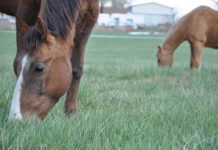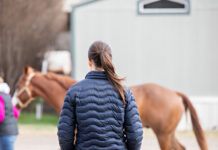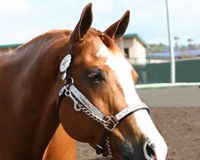Grooming is a multi-faceted aspect of horse ownership that keeps your equine friend happy, healthy and looking good. You groom as a part of your horse’s daily and seasonal care, to primp for a show, or to strengthen the bond you have with him. Here is a guide to what you need to know about grooming, including the tools you’ll use and how to use them, plus helpful tips and tricks to get the best results.
The most significant reason for grooming your horse is to maintain his health. It’s important to curry and brush his coat every day to prevent dirt and scurf (dead skin) from building up and causing skin problems such as saddle sores and rain rot, an infection that causes painful scabbing and hair loss on a horse’s back, shoulders and rump.
Besides maintaining your horse’s health and appearance, daily grooming sessions give you a chance to fortify the bond you have with him. You’ll also develop a keen sense for reading your horse’s moods and noticing any wounds or swelling.
Here is a list of the tools you should use for a thorough cleaning from head to hoof. Before you begin, tie your horse to a tie ring or hitching rail with a quick-release knot, or secure him to cross-ties that have quick-release snaps.
The Hooves
The soles of a horse’s feet are concave, and the frog, which aids in shock absorption, has deep clefts (grooves) on either side. Dirt and mud get packed into the hooves, especially if your horse is shod, and create the warm, moist environment that is perfect for the development of thrush. Therefore, picking feet should be the first job on your daily grooming agenda. In addition to clearing out the dirt and checking for thrush, you should be on the lookout for stones, bruises or abscesses that could cause pain and infection.
Facing your horse’s tail, run the hand closest to him down his leg, feeling for heat or swelling that could indicate an injury. If your horse doesn’t lift his hoof, gently squeeze the back of his fetlock or the chestnut. With the hoof pick in your opposite hand, pick the dirt out from heel to toe so you don’t inadvertently poke your horse’s leg. If your hoof pick has a brush on the back, use it to sweep away loose dirt. Follow these steps to clean all four of your horse’s hooves.
The Coat
A shiny coat is a sign of good health and regular care. Proper nutrition and an up-to-date deworming program help your horse shine from the inside out, but your grooming efforts add polish.
Curry Comb: Use the curry comb to lift dirt and loose hair to the surface of your horse’s coat. Curry combs are made of plastic, rubber or metal and come in various shapes and sizes. Soft plastic or rubber curry combs are the best to use on your horse every day. Hard plastic combs can cause a horse discomfort, so be aware of your horse’s reaction if you decide to use one, or save it for brushing his winter coat or for shedding season. Metal curry combs should only be used for two reasons: to facilitate shedding in the spring, and to clean your brushes periodically while you groom to prevent dirt and hair from building up and being redistributed over your horse’s body.
Curry your horse using as much pressure as he will tolerate and brush in circles, beginning at his neck and working toward his tail. Don’t use the curry comb on your horse’s sensitive face and legs.
Optional: A rubber grooming mitt is worn like a glove and contours to the horse’s body for a better curry. It can also be used gently to remove caked-on mud from the face and legs.
Hard/Stiff Brush: To remove the dirt, dander and loose hair brought up by the curry comb, use the hard brush (with stiff bristles) in short, quick strokes, flicking the brush away from your horse’s body. Work from head to tail and use no more force than your horse can stand. Because the bristles of this brush are rough, don’t use it on the face or the legs.
Medium Brush: Use a medium brush to pick up the dust left behind by the hard brush. Although the medium brush is softer than the hard brush, it is not soft enough to be used on the face or legs.
Soft Brush: You can give your horse’s coat a final sweep with the soft brush to pick up any lingering fine dust and dander, and to distribute the natural oils that bring out a healthy shine. With long, even strokes, start at your horse’s neck and finish at the tail. You can also use this brush on his legs and face, taking care around his eyes. Use a small sponge or clean, damp rag to clean your horse’s nostrils and around his eyes.
Optional: A fleece grooming mitt is a dust magnet and will leave your horse’s coat looking extra clean. It’s also ultra-soft, so it’s perfect for the face. A clean, dry towel will pick up dust and loose hair from the coat as well. There are also small, very soft brushes made specifically for grooming the face.
Hair Brush or Wide-Tooth Comb: A horse’s mane and tail hair is very coarse and can be thick. Left untended, the hair will become tangled with knots, dreadlocks, burrs and other debris. Running a vented or paddle brush with widely spaced plastic bristles—easily purchased at your local supermarket—or a wide-tooth comb through your horse’s hair on a regular basis can prevent bad hair days. However, using these brushes too often can result in a lot of hair breakage, which will thin the mane and tail, making them look sparse. Limit brushing to once or twice a week, and use your fingers to work through small snarls daily by gently pulling the hair away from the knot.
When you do use a comb or brush, spray a mane detangler in the hair first to minimize breakage. Brush the hair in small sections at a time, starting at the ends and working your way to the roots.
Splish, Splash
Occasionally, your horse will need a deeper clean than brushes can provide. A good scrubbing with shampoo and water washes away deep-down dirt and scurf that build up over time. However, bathing your horse too often will dry out his skin and strip away the natural oils that give his coat a healthy shine. Don’t bathe more than once or twice a month, and be sure to use shampoo formulated and pH-balanced for equine skin and coat—avoid harsh detergents as found in dish soaps.
Before you bring in your horse, set up the area you will be working in, placing all of the tools you need in a spot where you can easily reach them: a large and small sponge, equine shampoo, a hose or bucket of water, and a sweat scraper. Next, secure your horse to the cross-ties in a wash rack, if you have access to one, or ask a friend to hold him for you. Break down your bathing session into two parts—the mane and tail, and the body.
Mane & Tail
Start by washing the mane and tail so you can rinse off the shampoo that runs down your horse’s neck and legs when you wash his body. If you use a hose, fit it with a nozzle that allows you to adjust the pressure of the water. Begin by spraying your horse’s legs so he can get accustomed to the water, and then slowly move up to the mane.
If you opt to use the large sponge, dip it into a bucket of water and wet the mane. Apply the shampoo and work it into the hair with your fingers, paying close attention to the roots, where dirt and scurf accumulate. Thoroughly rinse the mane to prevent soap residue from drying and irritating the skin, which will cause your horse to rub. Use this same process to wash the tail. You can also apply conditioner to smooth the hair so it’s easier to brush out afterward. Be sure to thoroughly rinse out the hair again, unless it is a leave-in product.
Body Wash
When you’re confident that all of the soap has been rinsed out of your horse’s mane and tail, wet his body with the hose or the sponge. Apply shampoo directly to the sponge or add a few dollops to a bucket of clean water and dip the sponge into the lather. Gently scrub the shampoo into your horse’s coat, from his neck to his rump, and then rinse thoroughly. Use the small sponge with plain water to wipe away the dirt from his face. Most horses don’t like to be sprayed in the face with water, so refrain from using the hose. Avoid using soap, which could run into his eyes and cause irritation. Finally, remove the excess water from your horse’s body with the sweat scraper and use a clean towel to dry off his face and legs.
Weather Conditions
An important factor you need to take into consideration when it comes to bathing is the weather. Horses don’t like cold showers any more than we do, so limit bathing to the spring and summer, or when the temperature is above 50 degrees. You will need to cover him with a cooler after bathing on the chillier days. If you have access to a heated wash rack, you can bathe your horse during the winter months as long as you allow him to fully dry before turning him out. A better method for cold-weather bathing is to rub your horse down from head to hoof with a towel and hot water; this will pick up a lot of dust from a long winter coat. Soak the towel in a bucket of hot water and ring it out before wiping down your horse. This should be done indoors, out of the cold air. When you’re finished, dry him off with a clean towel and put a cooler on him.
Neat and Tidy
Whether you are preparing your horse for a show or just want him to look presentable, there are a few simple grooming practices that will keep him looking neat and tidy.
Pulling the Mane
A long mane requires daily care to prevent it from becoming a tangled mess. For shorter locks that are easy to maintain, pull the mane on a regular basis. This also helps to thin out a very thick mane and makes it easier to braid the hair if you’re going to a show.
Before you begin pulling your horse’s mane, you may need to train it to lie to one side of his neck, usually the right (check your discipline’s preference if you show). Wet and comb out the hair, then put it into small, tight braids that measure 1 inch wide at the top, securing them with rubber braiding bands at the bottom. Leave the braids in for no longer than three to four days.
When you remove the braids, wet and comb through the hair again to straighten it (don’t use detangling spray, which will leave the hair slippery), then begin pulling when it has dried. Start at the longest part of the mane, using a small metal comb designed for pulling. You can also wear rubber gloves for a better grip on the hair if you choose. Grasp the longest hairs of a 1-inch wide section of mane between your index finger and thumb, and then tease the rest of the hair up toward the crest of your horse’s neck. You should only be left with several strands of hair. Wrap those strands around the comb and sharply pull up or down, whichever is most comfortable for your horse. If the hair doesn’t come out, work with a smaller section of mane. The ideal length for a pulled mane is 4 inches.
Pulling the mane is uncomfortable for some horses. In this case, pull only small sections of the mane at a time over several days to get him accustomed to the procedure. Also try pulling your horse’s mane after exercise, when he is warm, so the pores are open and the hair comes out more easily. If your horse is very unruly, there are mane combs with a razor that leaves the hair with a natural edge. You shouldn’t use scissors—unless you can successfully cut vertically for a natural edge—as they leave the hair looking blunt and unnatural.
Clean Cut
To maintain your horse’s attractive, chiseled features, use a set of small clippers with a No. 10 blade to trim the long hair around his muzzle, ears, and under his jaw and chin.
When trimming the hair under your horse’s jawline, hold the clippers perpendicular to the ground and use them as comb, working in the direction of hair growth for a more natural trim, and to prevent you from cutting the hair too short.
To clean up your horse’s ears, cup your hand around the back of the ear and gently fold the edges in toward each other. Then clip the hair downward in one smooth motion from the tip of the ear to the base. Some horses are very sensitive about their ears, so use caution.
This is also a good time to trim your horse’s bridle path, which leaves a short, clean area just behind his ears for the bridle and halter to sit without getting tangled in his mane. Working against the direction of hair growth, trim a small section of mane as wide as two fingers (no more than 1 inch).
Finally, trim the shaggy hair at the back of your horse’s legs and fetlocks, using the clippers as you did when trimming the hair under his jaw. You can also clip the hair at the coronet band of your horse’s hooves; angle the clippers upward and edge around the hoof to create a clean line.
Trimming your horse in these areas won’t take too much time, making it a quick, easy way to keep him looking sharp.
Show Prep
Primping your horse for a show is a lot of hard work, but it pays off in the end when he looks his best. You should bathe your horse, braid his mane and do any necessary trimming the night before the show. If your horse is gray or has white socks, use specially formulated equine whitening shampoo to remove dirt and grass stains. To keep the braids intact overnight, you can outfit your horse in a stretchy nylon hood (available at tack stores).
For a show-worthy tail, use a pair of scissors to tidy up the ends. This is known as “banging” the tail. Ask a friend to hold her arm under the dock of the tail to simulate how your horse naturally carries it in motion. Grasp the end of the tail skirt in one hand and use the scissors to cut the hair straight across at the bottom. Be careful not to cut too short! At or above fetlock height is appropriate for most English and western disciplines.
When you arrive at the showgrounds, groom your horse as you normally would, then use an extra-soft finishing brush to bring out a healthy shine in his coat. You can also use a fleece grooming mitt and a silicone coat polish spray, but don’t apply any product to the area where the saddle sits, as this can cause the tack to slide around. Touch up any white areas and get rid of new stains with an on-the-spot coat-whitening spray. You and your horse will be ready to strut your stuff in front of the judges in no time.
Grooming your horse can be a chore at times, but look at it as an opportunity to bond with him. More importantly, it is a necessary task that keeps your horse happy and healthy.
Associate Editor Kim Abbott has become well-versed in grooming over her many years of horse experience.
This article originally appeared in the 2010 issue of Horses USA. Click here to purchase the most recent issue.







Great tips!!! I’ll use them on my horse i just got!!!
Thanks!